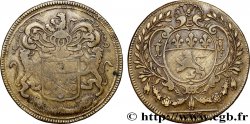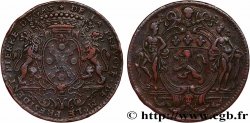fjt_078805 - LYONNAIS - CONSULATE OF LYON Jeton Br 27, Pierre de Sève 1647
Not available.
Item sold on our e-shop
Price : 38.00 €
Item sold on our e-shop
Price : 38.00 €
Type : Jeton Br 27, Pierre de Sève
Date: 1647
Metal : bronze
Diameter : 27 mm
Orientation dies : 6 h.
Rarity : R1
Coments on the condition:
Usure de circulation forte avec une partie des armoiries et des légendes effacée. Exemplaire convenable néanmoins, bien lisible et avec une patine marron
Catalogue references :
Obverse
Obverse legend : * DE. LA. SECONDE. PREVOSTE. DE. MONSR. DE. FLESCHERES.
Obverse description : Écu aux armes de Pierre de Sève, timbré d’un casque taré au tiers, orné de lambrequins.
Reverse
Reverse legend : (À 9 H.) MRS. SEVERAT. BASSET. CHOLIER. HONORAT. ESCH..
Reverse description : Écussons aux armes des quatre échevins, posés deux et deux et accompagnés de cimiers et lambrequins.
Commentary
Les armes de Pierre de Sève, baron de Fleschères, portent fascé d’or et de sable à la bordure contre-componée du même.








 Report a mistake
Report a mistake Print the page
Print the page Share my selection
Share my selection Ask a question
Ask a question Consign / sell
Consign / sell
 Full data
Full data



